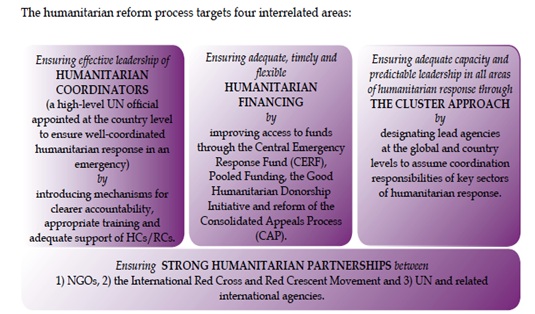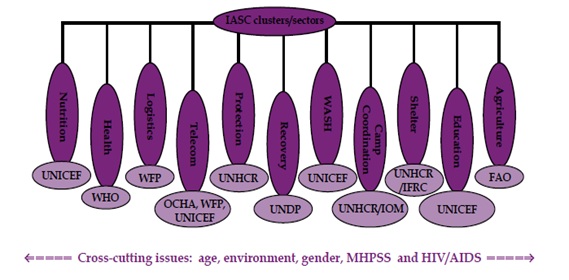- In the early 2000s, the humanitarian community faced several major crises: Afghanistan, Iraq, the Darfur conflict in Sudan, the Indian Ocean tsunami and the South Asia earthquake. These emergencies shone a spotlight on the humanitarian working environment because they called into question:
- The impartiality of humanitarian assistance.
- The appropriateness of responses.
- The capacity of agencies to respond.
- As a result, a UN-led comprehensive humanitarian reform process was launched in 2005 to improve international response to emergencies in humanitarian crises around the world and ensure that humanitarian operations would more efficiently, effectively and comprehensively meet the rights and needs of those most harmed by a crisis.

Excerpted from GBV AoR. 2011. Handbook for Coordinating Gender-based Violence Interventions in Humanitarian Settings, pg.31.
- The most visible aspect of the reform is the creation of the cluster approach. Clusters are groups of humanitarian organizations (UN and non-UN) working in the main sectors of humanitarian action, e.g. shelter and health. They are created when clear humanitarian needs exist within a sector, when there are numerous actors within sectors and when national authorities need coordination support.
- The Cluster Approach is a mechanism that can help to address gaps identified in humanitarian response and enhance the quality of humanitarian action. It is one of the four key strategies of humanitarian reform. A ‘cluster’ is essentially a group of organizations providing services within the same ‘theme” (for example, health) with one ‘lead’.
- Since September 2005 the Inter-Agency Standing Committee (IASC) has designated eleven global ‘cluster leads’, specifically for humanitarian emergencies, in eleven sectors or areas of activity: Agriculture; Camp Coordination & Management; Early Recovery; Education; Emergency Shelter; Emergency Telecommunications; Health; Logistics; Nutrition; Protection; and Water, Sanitation and Hygiene. In international responses to humanitarian crisis, these clusters leads work with UN and NGO partners to set standards and policies for the cluster, build standby response capacity and provide operational support to organizations working in the field.

Excerpted from GBV AoR. 2001. Handbook for Coordinating Gender-based Violence Interventions in Humanitarian Settings, pg.34.
- Five cross-cutting issues have also been designated for integration into the work of all the clusters: age, environment, gender, mental health and psychosocial support and HIV/AIDS. All clusters have a responsibility to mainstream the cross-cutting issues throughout their activities. Protection is also a cross-cutting issue and must be taken into account by all clusters, even though protection is designated as a cluster.
- For actors addressing violence against women in humanitarian crisis, it is important to note the role of the IASC Sub-Working Group on Gender and Humanitarian Action which supports the strategy for integration of gender as a cross-cutting issue into clusters and whose work extends to issues related to VAWG. Gender-based violence, on other hand, is addressed by an area of responsibility (AOR) of the Protection Cluster. In 2013, the sub-working group on gender was co-chaired by UN Women, UNHCR, WRC, and ICVA; the Gender-Based Violence Area of Responsibility was co-led by UNFPA and UNICEF; and the Protection Cluster was led by UNHCR.
- Prior to the introduction of humanitarian reform and the cluster approach, there were no standardized methods for introducing VAWG coordination mechanisms in humanitarian emergencies. Although the IASC GBV Guidelines, drafted just prior to the implementation of humanitarian reform, provide important directives for coordination in any humanitarian context, the cluster approach offers an explicit structure in which VAWG coordination can be established from the onset of an emergency.
Additional Resources
For additional information about humanitarian reform see:
Global Humanitarian Platform (GHP) website: Available in English.
Office for the Coordination of Humanitarian Affairs (OCHA) website: Available in English.
The OneResponse website includes FAQs on humanitarian reform, as well as the IASC Guidance Note on Using the Cluster Approach to Strengthen Humanitarian Response (November 2006) and the IASC Operational Guidance on Designating Sector/Cluster Leads in Major New Emergencies (May 2007): Avaialbe in English.
